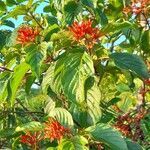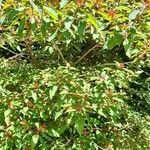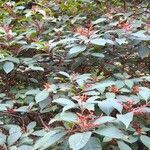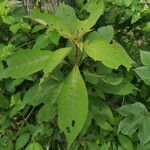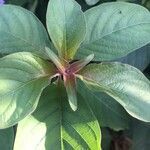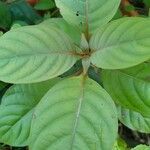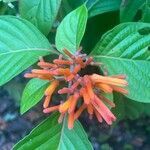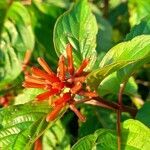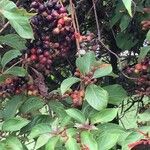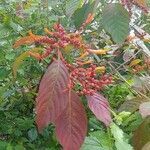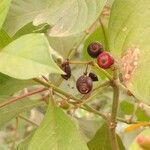Shrubs, deciduous, 1.5-4 m tall; branches angled to subterete, often becoming red, hirtellous or pilosulous to glabrescent. Leaves 2, 3, or 4(or 5) per node; petiole 1.5-4.5 cm, pilosulous or hirtellous to glabrous; blade drying papery to membranous, elliptic to oblanceolate, 7-20 × 4-6 cm, both surfaces pilosulous or hirtellous to glabrescent, base cuneate to acute, apex acute to weakly acuminate; secondary veins 7-9 pairs, in abaxial axils frequently with pilosulous domatia; stipules narrowly triangular to subulate, 2-6 mm, hirtellous or pilosulous to glabrescent. Inflorescences corymbiform, villosulous or pilosulous to glabrescent; peduncle 1-8 cm; branched portion corymbiform, 1.5-7 × 1.5-9 cm; bracts reduced or triangular, 0.2-0.5 mm. Flowers subsessile to pedicellate; pedicels to 2 mm. Calyx hirtellous to glabrous; ovary portion ellipsoid, ca. 3 mm; limb deeply lobed; lobes triangular, 0.8-1 mm. Corolla red to red-orange or yellow, narrowly tubular, outside puberulent to glabrous; tube smooth to shallowly 5-ribbed, 16-23 mm; lobes ovate-triangular, 1-2 mm, acute. Berry ovoid, 6-7 mm in diam., puberulent to glabrescent. Fl. May-Dec.
An erect shrub or small tree. It grows 7 m tall. It spreads 2-5 m wide. The leaves are simple and dull green. They are 5-10 cm long and broadly oval. They are softly hairy. The flowers are orange-scarlet. They are 2 cm across. They are downy and tube shaped. The fruit are berries and are 8 mm across. They are fleshy and red to purple.
